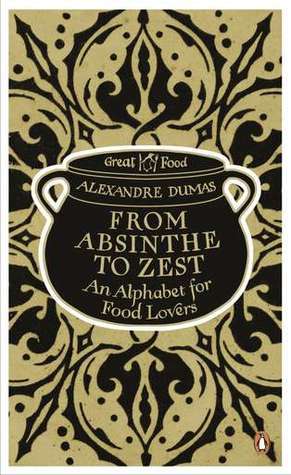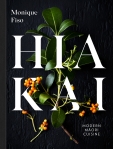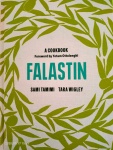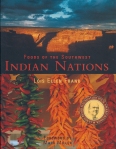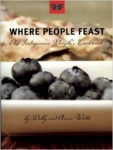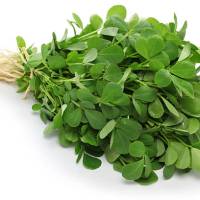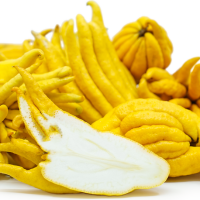I came across this tiny (insubstantial) book amongst my food books the other day. I have no idea where I got it, who might have given it to me (apologies if it was you), or how long I have had it. But it set me on a journey of discovery that I am going to tell you about today and I hope it entertains you.
Of the 303 volumes commonly said to have been written by Alexandre Dumas his last book and the one he hoped to leave as a final grand memorial to his writing was one not included in the 303. His ‘cookery book’, Le Grande Dictionary de cusine, was published posthumously in 1873, three years after his death.
Born Dumas Davy de la Pailleterie in 1802, Alexandre Dumas was 68 years old when he died. Wikipaedia tells better than I can the familial history of Dumas, but it involves colonialism at it ‘finest’ – aristocracy, slaves, concubines, and a mixed heritage lineage. His father, suffering Napolean’s disfavour, died when Dumas was 3 years old, consigning Dumas to a childhood of, if not poverty, then certainly modest means.
He received little formal education and was taught to read and write by his sister and mother. As a teenager he was more interested in action than study and spent a lot of time in forests with local poachers. The event which finally began his career as a dramatist was a play by Shakespeare. As he himself put it: ‘I was blind, and Shakespeare has brough me light.’ (A & J Davison, 1978, Dumas on Food)
His first play was published in 1829 and first serial novel, La Comtesse de Salisbury, was published in 1836. This was followed with prodigious regularity by all of the 303 titles that may be new to us and those with which we are familiar, such as The Count of Monte Cristo (1844), The Three Muscateers (1844) and The Man in the Iron Mask (1850). He wrote plays, serials, novels, non-fiction, and especially his travel journals.
Dumas married actress Ida Ferrier in 1840 and they remained married until her death in 1849. He is believed to have had about 40 mistresses, with whom he fathered between four and six children. He acknowledged Alexandre Dumas fils (who also became a writer) at age seven and took over his education, separating him from his mother (Claude Schopp). English playwright Watts Phillips, who knew Dumas in his later life, described him as “the most generous, large-hearted being in the world. He also was the most delightfully amusing and egotistical creature on the face of the earth. His tongue was like a windmill – once set in motion, you never knew when he would stop, especially if the theme was himself.”
However, Dumas’s fortunes waxed and waned throughout his life. In 1852 he left Paris for Brussels partly to escape his creditors. It is noted that his lowest point came in the last year of his life, ‘when he was ill, impoverished and tormented by doubts about the enduring quality of his work’. At this point his work had been out of favour for about ten years. He had thought about writing his food book for many years and in 1869 departed to Roscoff on Cape Finisterre. He took little with him in the way of contemporary cookbooks, he said he took ‘ only a small collection of notes and books and relied rather on his memory’ (T. Jaine, 2014). The manuscript was delivered ‘almost finished’ in March of 1870 and Dumas died, in Dieppe, on 5th December 1870 without seeing publication of the book.



The book was printed in 1872 with publication the following year. There was no second edition and when the publishers, Lemerre, ceased in the 1950’s, any copies remaining were burned. This paved the way for a number of ‘coffee table’ editions. An inferior abridged edition (Le Petit Dictionnaire de Cusine) was published by Lemerre in 1882 but this omitted much of the reminicences and anecdotal material as well as a huge number of recipes all of which had contributed to the charm of the original. In 1978 Alan and Jane Davison translated Dumas on Food which consisted of selections from Le Grande Dictionnaire de Cusine (Alden Press, Oxford). My own little copy, called From Absinthe to Zest, was a Penguin production from 2011 and simply contains a selection of the A-Z entries (as well as an abreviated introduction by Dumas).
Le Grande Dictionary de Cuisine is extraordinary in its composition. The book of 1150 pages was 600,000 words long with two illustrations. The contents consisted of a letter from the publisher to M.Vuillemot, the principal adviser to Dumas on cuisine; a 33 page introduction by Dumas; a description by Victor Hugo for a model kitchen; a letter from Dumas to Jules Janin ( a dear friend, novelist, journalist, and theater critic) on various gastronomic topics; a calendar of gastronomy drawn from Grimond de la Reyniere’s book Almanach des gourmands; an additional introduction by Dumas; the dictionary itself which occupied pages 107-1138; various menus, and an annexe containing an essay on mustard followed by an advertisemnet for Bornibus mustard and other adverts by wine and food merchants. It is both disorganised, and often incorrect, it relies on recipes from other sources (often unattributed), but is full of anecdotes, whimsy, and reminicences which ‘are written with verve and are entertaining’. It is a ‘witty and gloriously eccentric culinary compendium’ (Penguin, 2011).
Dumas wrote the book to contain ‘both scientific knowledge and an element of wit so that it would not seem too daunting to the practitioners and would also deserve to be read by men of serious character – and even by women of a much lighter disposition’.
Dumas, in his introduction spends some time on why he decided to write this book, saying,
‘What especially tempted me, the indefagitable traveller who had voyaged through Spain and Italy, countries where one eats poorly, and through the Caucasus and Africa, countries where one does not eat at all, was to indicate all the ways of eating better in the former category of coutries and of eating somehow or other in the latter category; granted that to achieve this result one would have to be prepared to do one’s own hunting and foraging’.
He was no more complimentary about German Cherry Soup, saying, ‘ It is a detestable dish of squashed cherries and pounded cherry stones, all fiercely spiced, drowned in wine and served cold’. On the topic of oil, mainly olive oil, he has this to say, ‘ Although Italy and Spain are covered with olive trees, it is these two countries which produce the worst olive oil….This applies likewise to the oil which is produced in Greece, Syria and Egypt’. England too was also deemed inadequate, this time in the production of Stews (Ragouts), ‘Stews, above all, were responsible for the brilliance of old French cookery; yet it is stews which bring disgrace on contemporary cuisines, especially that of England’.
He is though uncharacteristically comment free when describing how to make Lapin Gallois, or Welch Rabbit saying it is ‘
A kind of English toast. Butter some slices of bread and toast them until they are a beautiful colour. Have some English Gloucester cheese, or something similar, cut into small pieces. Melt these with a little water in a timbale. Add some Cayenne pepper, spread the melted cheese on the toast, glze it with a pell rouge (but held at a distance), then delicately place a little fresh butter on top of each toast, with just a touch of English mustard.
Some entries told stories such as the one for coffee. He says,
‘Coffee comes originally from the Yemen, in Arabia Felix. The Arab historian, Ahmet-Effendi, thinks it was a dervish who discovered coffee, in about the fifteenth century, or in the year of 650 of the Hegira…The First European to refer to the coffee plant was Prosper Alpin, of Padua. In 1580 he accompanied a Venetian consul of Egypt. I have seen this tree in Cairo. It is called bon or boun. With the berry which it produces, the Egyptians produce a drink which Arabs call Kawa. The taste for coffee grew to such an extent at Constantinople that the Imans complained that the mosques were deserted whereas the cafes were always full. Amurat III then permitted coffee to be consumed in private houses, as long as the doors were shut’.
As to garlic, well… Did you know that conscripts used it to obtain a discharge. Saying, everyone recognises the smell, apart from the person who has eaten it, Dumas tells us that Athenaeus said that those who ate garlic never entered the temples consecrated to Cybele and that the poet, Macer, talked about it as a deterrent against falling asleep when there were snakes to be feared. The Egypians adored it, the Greeks detested it. The Romans ate it with pleasure. But Alphonso, King of Castile, disliked garlic so much that in 1330 he founded an order, the statutes of which laid down that those knights who had eaten garlic (or onion) could neither appear at court nor communicate with other knights, for at least one month.
One story, concerning potatoes reminds us that community gardens are not a modern invention, when Dumas writes,
‘In 1793 potatoes were considered so indispensible that a decree of the Commune ordered a census to be takenof luxury gardens, so that they could be devoted to the cultivation of this vegetable. As a result, the principal avenue in the Jardin des Tuileries and the flower beds were turned over to potato cultivation. This is why potatoes were for a long time given the additional name of ‘royal oranges’.
There are entries less witty or whimsical – the mass slaughter of skylarks, the breeding of dogs for consumption, but I am not going to detail those here. And as for figs. Seemingly it was a fig that decided the Roman senate to destroy Carthage. But that is a story for another time. The book is full of bits and pieces of history, gossip, culture, reminiscence – and also lots of recipes, some incomprehensible and some straightforward. The one I have chosen for today is Dumas’s strawberry omelette which is contained in the small Penguin volume (page 64-5) From Absinthe to Zest, 2011


